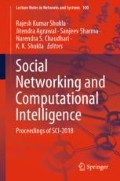Abstract
This article having a significant analysis of the Mumbai terrorist attack held on November 26, 2011, using a decision based on multi-criteria which are a potential approach for the social network analysis. The data source for this analysis is a dossier report on 26/11 Mumbai attack submitted to the Ministry of External Affairs that was published in the year 2009 and many more articles. This report gives the complete details about this tragic event consisting number of terrorist involved in India as well as from Pakistan, points where they had done operation, their communications in between, number of casualties, etc. When law enforcement agencies want to analyze any terrorist attack concerning key players involved in the attack, investigators should consider more than one criterion or factors that may also inconsistent and contradictory. Therefore, key player selection and ranking of terrorist nodes are a multi-criteria decision-making issue. AHP resolves this multi-criteria decision-making issue. This study reveals the key players and ranked them accordingly, involved in 26/11 Mumbai terrorist attack using the analytic hierarchy process (AHP).
Access this chapter
Tax calculation will be finalised at checkout
Purchases are for personal use only
References
Fenstermacher L, Rieger KT, Speckhard A (2010) Protecting the homeland from international and domestic terrorism threats. White Paper: Counter Terrorism, p 178
Acharya A, Mandal S, Mehta A (2009) Terrorist attacks in Mumbai: picking up the pieces. International Centre for Political Violence and Terrorism Research S. Rajaratnam School for International Studies Nanyang Technological University, Singapore
Gunaratna R (2009) Mumbai investigation: the operatives, masterminds and enduring threat. UNISCI Discussion Paper, no 19, p 142
Onook O, Agrawal M, Rao R (2010) Information control and terrorism: tracking the Mumbai terrorist attack through twitter
Azad S, Gupta A (2011) A quantitative assessment on 26/11 Mumbai attack using SocialNetwork Analysis. J Terrorism Res V2(I2):4–14
A report on Mumbai attack (2009) Mumbai terrorist attack (26–29 Nov 2008). Govt. Of India
Marsden P (2015) Network centrality, measures of International Encyclopedia of the Social & Behavioral Sciences, pp. 532–539
Magnier M, Sharma S (2008) India terrorist attacks leave at least 101 dead in Mumbai. Los Angeles Times. p A1. Retrieved 28 Nov 2008
Masood S (2009) Pakistan announces arrests for Mumbai Attacks. Inf Syst Front 13(1):33–43. (New York Times. Retrieved 12 Feb 2009)
Chaurasia N, Tiwari A (2014) On the use of brokerage approach to discover influencing nodes in terrorist networks. In: Social networking: mining, visualization, and security, 1st edn, vol 65, Intelligent Systems Reference Library 65. Springer, Cham, pp 271–295. https://doi.org/10.1007/978-3-319-05164-2
De S, Dehuri S (2014) Machine learning for auspicious social network mining. In: Social networking: mining, visualization, and security, 1st edn, vol 65. Intelligent systems reference library 65. Springer, Cham, pp 45–83. https://doi.org/10.1007/978-3-319-05164-2
Freeman L (1977) A set of measures of centrality based on betweenness. Sociometry 40:35–41. https://doi.org/10.2307/3033543
Bonacich P (2007) Some unique properties of eigenvector centrality. Soc Netw 29:555–564
Katz L (1953) A new status index derived from sociometric analysis. Psychometrika 18(1):39–43
Mariani MS, Medo1 M, Zhang Y-C (2015) Ranking nodes in growing networks: when PageRank fails. Sci Rep 5(Article number: 16181):1–10. https://doi.org/10.1038/srep16181
Saaty TL, Rogers PC, Pell R (1980) Portfolio selection through hierarchies. J Portfolio Manag 6(3):16–21. https://doi.org/10.3905/jpm.1980.408749
Author information
Authors and Affiliations
Corresponding author
Editor information
Editors and Affiliations
Rights and permissions
Copyright information
© 2020 Springer Nature Singapore Pte Ltd.
About this paper
Cite this paper
Kumar Mishra, A., Joshi, N., Mathur, I. (2020). Using Analytic Hierarchal Processing in 26/11 Mumbai Terrorist Attack for Key Player Selection and Ranking. In: Shukla, R., Agrawal, J., Sharma, S., Chaudhari, N., Shukla, K. (eds) Social Networking and Computational Intelligence. Lecture Notes in Networks and Systems, vol 100. Springer, Singapore. https://doi.org/10.1007/978-981-15-2071-6_33
Download citation
DOI: https://doi.org/10.1007/978-981-15-2071-6_33
Published:
Publisher Name: Springer, Singapore
Print ISBN: 978-981-15-2070-9
Online ISBN: 978-981-15-2071-6
eBook Packages: Intelligent Technologies and RoboticsIntelligent Technologies and Robotics (R0)

